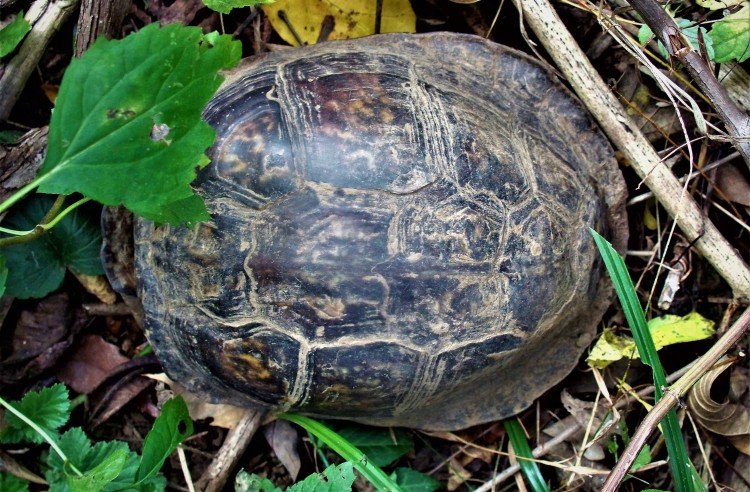
Why do plants and animals live the life spans they do? When I’m old in human years, I’m still young next to the massive Pin Oak in my backyard. But most of the animal species in our forest will enjoy a much shorter lifespan than me, except for one – the Eastern Box Turtle. As with other members of its turtle clan, a slow metabolism and heavily armored carapace mean there’s a good chance at a long life. Box Turtles don’t even mature sexually till between five and ten years of age, but can still reproduce into their fifties and beyond.

But how did we figure out just how long they can live? One of the problems with estimating the age of a Box Turtle is that they all look old. The female in the pic below is relatively young, (20 to 30 years) based on the number and condition of the scute (scale) lines on her carapace. But to look at her wrinkly scaly skin, we might assume she is quite aged.

One of the first clues to Box Turtle longevity was the outdated (hopefully) custom of carving one’s initials along with the date, into box turtle plastrons. These little grabs at posterity can be quite useful to scientists, as in the pic below. This turtle was observed in Rhode Island in 1955 (still healthy and active), with the well worn dates of 1844 and 1860 still visible on its underside. Since the practice of carving on boxies was relatively common back in the day, researchers think the dates are likely authentic – meaning this turtle and many others topped the 100 year mark!
![oldboxturtle[1]](https://oneforestfragment.files.wordpress.com/2017/05/oldboxturtle1-e1495372955786.jpg?w=438&h=553)
But lacking any convenient carvings, how do we determine the age of any random turtle we meet? Young ones are easy; the scute lines are prominent, unworn, and relate somewhat to the age of the turtle (though not exactly). Their scute patterns are still basic, not having grown into the beautifully unique complexity of mature boxies. And they’re still little; turtles continue to grow till reaching mature size about the age of twenty. However, most of the oldest turtles I have observed were larger and heavier than the usual adult.

- It’s a good guess this one is less than ten years old
Most wild Boxies we see are in the young adult to middle aged range, from about 15 to 40 years old. If a turtle can survive this long it has a good chance of getting much older. The main threats it could encounter – disease, mowers, cars, human collectors, habitat destruction.

A middle aged turtle can have significant healed damage to its carapace, as does the lucky fellow in the pic below.

But it’s not the same as the carapace of a truly old turtle. Though I’ve met ones that looked much older than usual, I had no support for my opinion until I came across this:
Quoting from a study by Lucille Stickell, a famous early researcher of Box turtles – “As turtles become older, the clear-cut ridges of the growth lines gradually smooth. Eventually the outer layer of horn peels off, exposing a second layer closely adherent to the bone; the carapace is then so smooth that it is not feasible to count growth lines.”
Considering this, here are pics of two turtles living in our forest that are likely quite old. How old? Since a Box Turtle’s typical lifespan is about 50 years, I will go out on a limb and say these two are likely 60, 70, 80 years plus. The only way to be absolutely sure is to follow a young turtle over many decades, that was marked as part of a research study. There are boxies over 80 that have been fully documented this way.




If these turtles are 80 years or older, they lived in a very different sort of forest as youngsters. The pic below shows our forest fragment when it was even more of a fragment. In the 1930’s the swampy bottomland portion had been ditched and drained, and was being used for crops. The bits of pasture and woodland were grazed by livestock, and most of the trees were young.

Contrast this with a pic taken recently; forest has recovered most of the former clearings.

But a fragment of forest here and there, however nice the habitat, is still just a fragment. And female Box Turtles in particular, may need to venture outside of these fragments to find sunnier spots for nesting, placing them at risk.
Along with the capacity for longevity, boxies have a very slow rate of reproduction. The only way mating happens is if a male and female see each other – no mating calls or pheromone scents. A female may store sperm up to four years in case she doesn’t meet another male, and as populations dwindle a meetup is less assured. Though a female may lay many hundreds of eggs in her lifetime, turtle researchers believe only a fraction ever get to hatch, much less live beyond infancy (thanks to abundant populations of raccoons and skunks).
It’s very hard for researchers to even determine how many young boxies are out there, since they’re completely in hiding for their first couple years. The hinge between the carapace and plastron isn’t developed yet, and their shell is still soft, so they’re food for many other animals.

The next time you encounter a wild boxie, take a closer look. She or he has likely lived their entire life within a small portion of the surrounding area – termed its “home range”. Through a long life it has come to know every feature intimately. There are rotten tree trunks to hibernate under or search for food in, wet places to cool off when it’s hot, bushes and trees with berries. Show some respect, and please don’t move it from this spot – this turtle may be older than you.

sbnightingale
❤
LikeLike